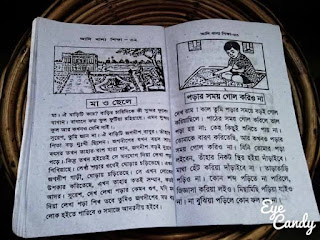পেয়ে গেছি ! পেয়ে গেছি ! পেয়ে গেছি !
অনেক দিন ধরে খুজে বেড়াচ্ছি এই পবিত্র ধন ! যা কিনা মানুষকে সভ্য হতে সহায়তা করে, ভাষা- শিক্ষা, আদব-কায়দা, জ্ঞ্যান ও সম্মান করতে শিখায়। যিনি এত সুন্দর শিক্ষার আয়োজন করে গেছে, বাংলা ভাষা ভাষী মানুষকে শিক্ষা ও যথার্থ জ্ঞ্যান অর্জনে সহায়তা করে গেছেন তিনি হচ্ছেন "রামসুন্দর বসাক"
শিশুদের জন্য বর্ণপরিচয় রচনার গোড়ায়ই এসে পড়ে বর্ণমালার কথা। আমরা জানি ব্রাহ্মীলিপি থেকেই বিবর্তিত হয়ে বাংলা বর্ণমালার উদ্ভব হয়েছে। এ বিবর্তন প্রক্রিয়া চলেছে তিন হাজার বছরেরও বেশি সময় ধরে। তবে বলা যেতে পারে, বিদ্যাসাগরের হাতেই বাংলা বর্ণমালার যথাযথ উন্নতি হয়েছে, যে মৌলিক উন্নয়নের পর পরবর্তী সার্ধশতবছরে মাত্র কিছু সংস্কারমূলক কাজ হয়েছে। তাঁকে প্রথমত বর্ণমালার প্রকৃতি ও সংখ্যা নির্ধারণ করতে হয়েছে। ১৭৬৮ খ্রিস্টাব্দে প্রকাশিত হালেদের বইয়ে স্বরবর্ণের সংখ্যা ছিল ১৬। পরবর্তী প্রায় একশত বছর মদনমোহনের শিশুশিক্ষা প্রথম ভাগ পর্যন্ত স্বরবর্ণের সংখ্যা ১৬টিই ছিল। এগুলো হলো অ, আ, ই, ঈ, উ, ঊ, ঋ, ৠ, ঌ, ৡ, এ, ঐ, ও, ঔ, অ০, অঃ। বিদ্যাসাগর এই সংখ্যা কমিয়ে ১২তে নামালেন। তিনি ভূমিকায় লিখলেন:
"বহূকালাবধি বর্ণমালা ষোল স্বর ও চৌত্রিশ ব্যঞ্জন এই পঞ্চাশ অক্ষরে পরিগণিত ছিল। কিন্তু বাঙ্গালা ভাষায় দীর্ঘ ৠ-কার ও দীর্ঘ ৡ-কারের প্রয়োজন নাই। এই নিমিত্ত ঐ দুই বর্ণ পরিত্যক্ত হইয়াছে। আর সবিশেষ অনুধাবন করিয়া দেখিলে অনুস্বার ও বিসর্গ স্বরবর্ণ মধ্যে পরিগণিত হইতে পারে না। এই নিমিত্ত ঐ দুই বর্ণ ব্যঞ্জনবর্ণ মধ্যে পঠিত হইয়াছে। আর চন্দ্রবিন্দুকে ব্যঞ্জনবর্ণস্থলে এক স্বতন্ত্র বর্ণ বলিয়া গণনা করা গিয়াছে। "ড, ঢ, য এই তিন ব্যঞ্জনবর্ণ পদের মধ্যে অথবা পদের অন্তে থাকিলে, ড়, ঢ়, য় হয়।""
বিদ্যাসাগরের এই মৌলিক সংস্কারের ১২৫ বছর পর স্বরবর্ণে মাত্র আর একটি সংস্কার ঘটেছে, তাহলো ঌ বর্ণটি বাদ দেওয়া। এখন স্বরবর্ণ ১১টি। ব্যঞ্জনবর্ণ ছিল ৩৪টি। বিদ্যাসাগর তাতে নতুনভাবে ছয়টি বর্ণ যুক্ত করেন। অনুস্বার ও বিসর্গকে স্বরবর্ণ থেকে ব্যঞ্জনবর্ণে নিয়ে এসে চন্দ্রবিন্দুকেও যোগ করে দিলেন। ড, ঢ, য-এর দ্বিবিধ উচ্চারণের ক্ষেত্রে নিচে ফুটকি বা শুন্য দিয়ে নতুন তিনটি ব্যঞ্জন অক্ষর আবিষ্কার করলেন। তা ছাড়া বিদ্যাসাগর দেখলেন, "বাঙ্গালা ভাষায় একারের ত, ত্ এই দ্বিবিধ কলেবর প্রচলিত আছে।" তাই এটিকেও ব্যঞ্জনবর্ণে যুক্ত করেছেন। আর ক্ষ যেহেতু ক ও ষ মিলে হয় "সুতরাং উহা সংযুক্তবর্ণ, এ জন্য অসংযুক্ত ব্যঞ্জনবর্ণ গণনাস্থলে পরিত্যক্ত হইয়াছে।" এভাবে তাঁর হাতে ব্যঞ্জনবর্ণ হলো ৪০টি। এর মধ্যে স্বরবর্ণ ঌ-এর মতই শুধু অন্তঃস্থ 'ব' বর্ণটি বাদ যায়। এখন ব্যঞ্জনবর্ণ ৩৯টি।
যারা কখনো দেখেন নি বা যারা এই বই পড়েছেন তাদের স্মরন করিয়ে দেবার জন্য এই পোষ্ট। (সংগ্রীহীত)














অনেক দিন ধরে খুজে বেড়াচ্ছি এই পবিত্র ধন ! যা কিনা মানুষকে সভ্য হতে সহায়তা করে, ভাষা- শিক্ষা, আদব-কায়দা, জ্ঞ্যান ও সম্মান করতে শিখায়। যিনি এত সুন্দর শিক্ষার আয়োজন করে গেছে, বাংলা ভাষা ভাষী মানুষকে শিক্ষা ও যথার্থ জ্ঞ্যান অর্জনে সহায়তা করে গেছেন তিনি হচ্ছেন "রামসুন্দর বসাক"
শিশুদের জন্য বর্ণপরিচয় রচনার গোড়ায়ই এসে পড়ে বর্ণমালার কথা। আমরা জানি ব্রাহ্মীলিপি থেকেই বিবর্তিত হয়ে বাংলা বর্ণমালার উদ্ভব হয়েছে। এ বিবর্তন প্রক্রিয়া চলেছে তিন হাজার বছরেরও বেশি সময় ধরে। তবে বলা যেতে পারে, বিদ্যাসাগরের হাতেই বাংলা বর্ণমালার যথাযথ উন্নতি হয়েছে, যে মৌলিক উন্নয়নের পর পরবর্তী সার্ধশতবছরে মাত্র কিছু সংস্কারমূলক কাজ হয়েছে। তাঁকে প্রথমত বর্ণমালার প্রকৃতি ও সংখ্যা নির্ধারণ করতে হয়েছে। ১৭৬৮ খ্রিস্টাব্দে প্রকাশিত হালেদের বইয়ে স্বরবর্ণের সংখ্যা ছিল ১৬। পরবর্তী প্রায় একশত বছর মদনমোহনের শিশুশিক্ষা প্রথম ভাগ পর্যন্ত স্বরবর্ণের সংখ্যা ১৬টিই ছিল। এগুলো হলো অ, আ, ই, ঈ, উ, ঊ, ঋ, ৠ, ঌ, ৡ, এ, ঐ, ও, ঔ, অ০, অঃ। বিদ্যাসাগর এই সংখ্যা কমিয়ে ১২তে নামালেন। তিনি ভূমিকায় লিখলেন:
"বহূকালাবধি বর্ণমালা ষোল স্বর ও চৌত্রিশ ব্যঞ্জন এই পঞ্চাশ অক্ষরে পরিগণিত ছিল। কিন্তু বাঙ্গালা ভাষায় দীর্ঘ ৠ-কার ও দীর্ঘ ৡ-কারের প্রয়োজন নাই। এই নিমিত্ত ঐ দুই বর্ণ পরিত্যক্ত হইয়াছে। আর সবিশেষ অনুধাবন করিয়া দেখিলে অনুস্বার ও বিসর্গ স্বরবর্ণ মধ্যে পরিগণিত হইতে পারে না। এই নিমিত্ত ঐ দুই বর্ণ ব্যঞ্জনবর্ণ মধ্যে পঠিত হইয়াছে। আর চন্দ্রবিন্দুকে ব্যঞ্জনবর্ণস্থলে এক স্বতন্ত্র বর্ণ বলিয়া গণনা করা গিয়াছে। "ড, ঢ, য এই তিন ব্যঞ্জনবর্ণ পদের মধ্যে অথবা পদের অন্তে থাকিলে, ড়, ঢ়, য় হয়।""
বিদ্যাসাগরের এই মৌলিক সংস্কারের ১২৫ বছর পর স্বরবর্ণে মাত্র আর একটি সংস্কার ঘটেছে, তাহলো ঌ বর্ণটি বাদ দেওয়া। এখন স্বরবর্ণ ১১টি। ব্যঞ্জনবর্ণ ছিল ৩৪টি। বিদ্যাসাগর তাতে নতুনভাবে ছয়টি বর্ণ যুক্ত করেন। অনুস্বার ও বিসর্গকে স্বরবর্ণ থেকে ব্যঞ্জনবর্ণে নিয়ে এসে চন্দ্রবিন্দুকেও যোগ করে দিলেন। ড, ঢ, য-এর দ্বিবিধ উচ্চারণের ক্ষেত্রে নিচে ফুটকি বা শুন্য দিয়ে নতুন তিনটি ব্যঞ্জন অক্ষর আবিষ্কার করলেন। তা ছাড়া বিদ্যাসাগর দেখলেন, "বাঙ্গালা ভাষায় একারের ত, ত্ এই দ্বিবিধ কলেবর প্রচলিত আছে।" তাই এটিকেও ব্যঞ্জনবর্ণে যুক্ত করেছেন। আর ক্ষ যেহেতু ক ও ষ মিলে হয় "সুতরাং উহা সংযুক্তবর্ণ, এ জন্য অসংযুক্ত ব্যঞ্জনবর্ণ গণনাস্থলে পরিত্যক্ত হইয়াছে।" এভাবে তাঁর হাতে ব্যঞ্জনবর্ণ হলো ৪০টি। এর মধ্যে স্বরবর্ণ ঌ-এর মতই শুধু অন্তঃস্থ 'ব' বর্ণটি বাদ যায়। এখন ব্যঞ্জনবর্ণ ৩৯টি।
যারা কখনো দেখেন নি বা যারা এই বই পড়েছেন তাদের স্মরন করিয়ে দেবার জন্য এই পোষ্ট। (সংগ্রীহীত)












